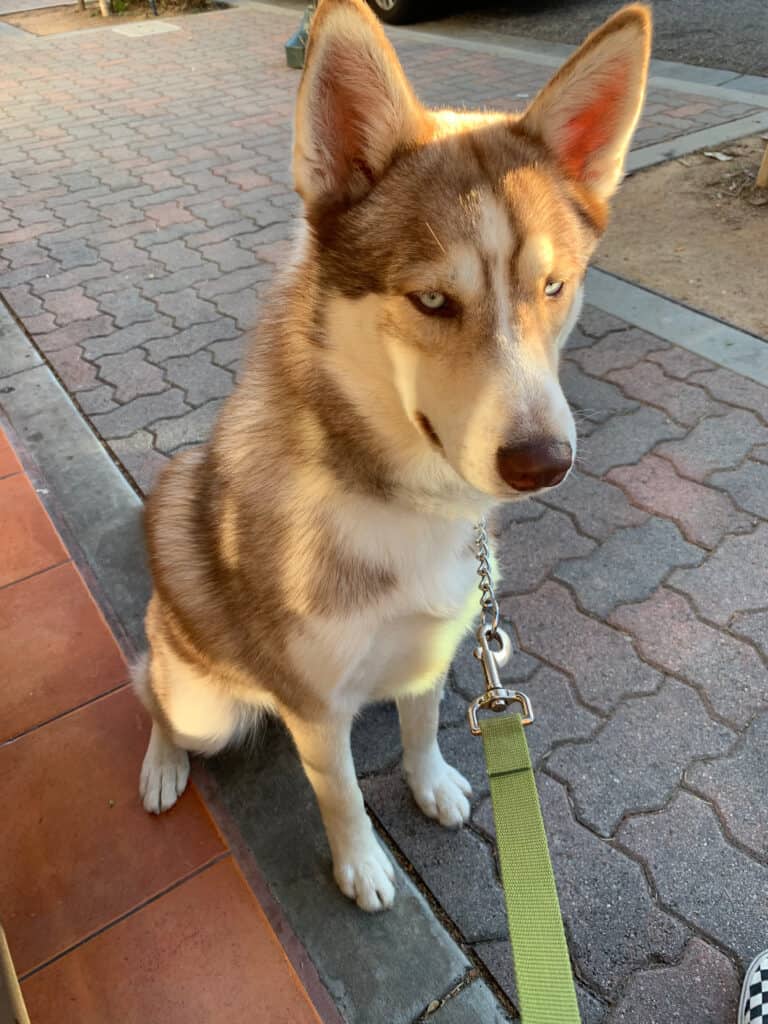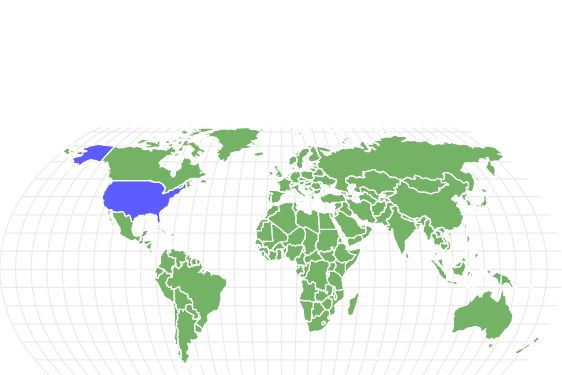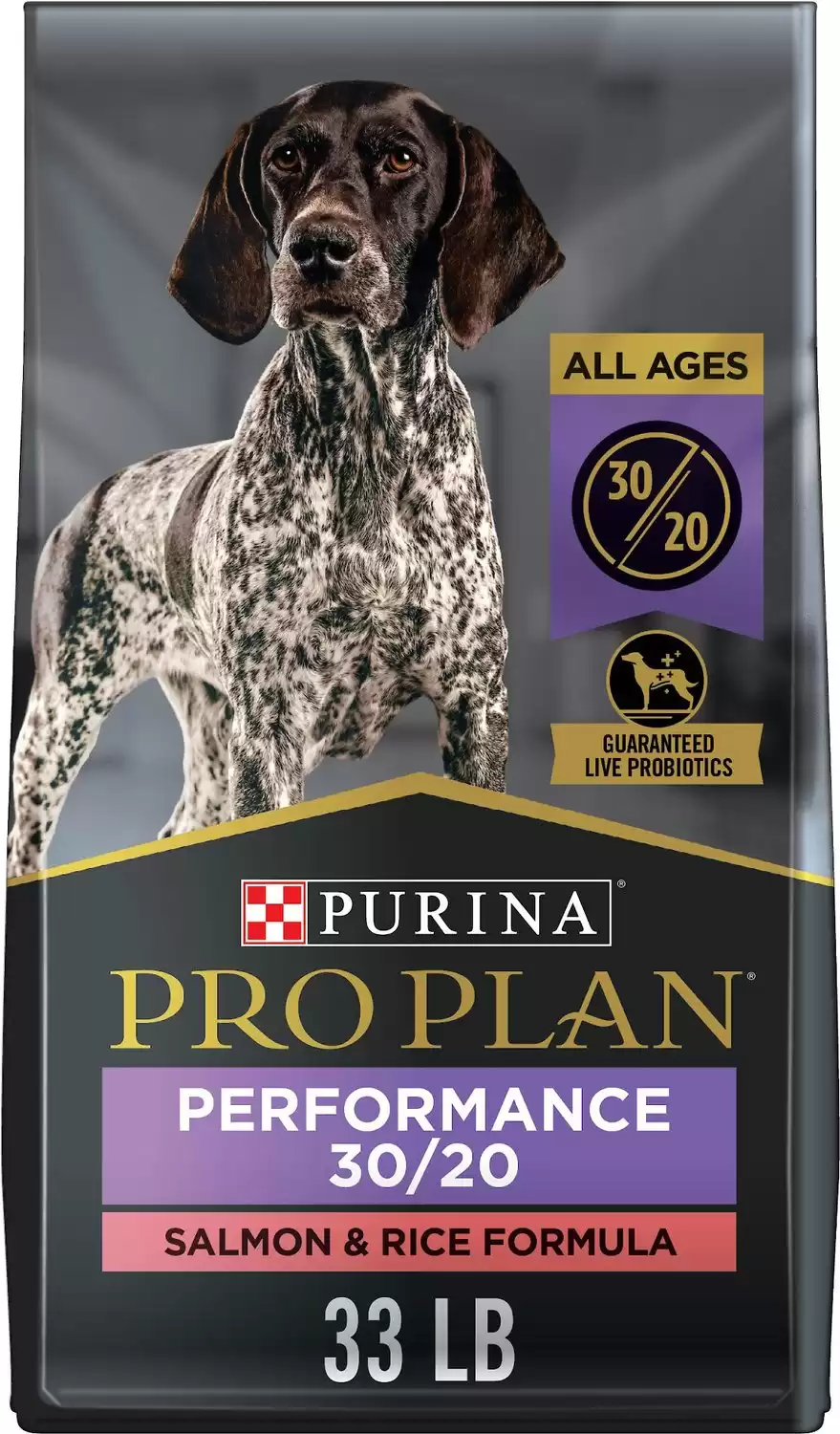Huskita
Canis lupus
Huskitas prefer a consistent daily routine with lots of activity.
Advertisement
Huskita Scientific Classification
- Kingdom
- Animalia
- Phylum
- Chordata
- Class
- Mammalia
- Order
- Carnivora
- Family
- Canidae
- Genus
- Canis
- Scientific Name
- Canis lupus
Read our Complete Guide to Classification of Animals.
Huskita Conservation Status
Huskita Facts
- Name Of Young
- puppy
- Fun Fact
- Huskitas prefer a consistent daily routine with lots of activity.
- Most Distinctive Feature
- triangular, erect ears
- Temperament
- high energy
Huskita as a Pet:
- General Health
- Energy Level
- Shedability
- Trainability
- Intelligence
- Tendency to Chew
- Size
- Family and kid friendliness
- Yappiness / Barking
- Low
- Separation Anxiety
- High
- Preferred Temperature
- Cold climate
- Exercise Needs
- High
- Friendly With Other Dogs
- Poor
- Pure bred cost to own
- $500 to $1,200
- Dog group
- Non-sporting
- Male weight
- - lbs
- Female weight
- - lbs
This post may contain affiliate links to our partners like Chewy, Amazon, and others. Purchasing through these helps us further the A-Z Animals mission to educate about the world's species.
View all of the Huskita images!
Huskitas are highly intelligent dogs preferring a consistent daily routine that keeps them active, including about 90 minutes of exercise with their human each day.
Huskitas, also called the Siberian Akita, is a mix of the Siberian Husky of Russia and Akita Inu of Japan. Drawing traits from both of their parent breeds, these active dogs are loyal with an average lifespan of 10 to 13 years. They also have the dense, rough, medium-length, not hypoallergenic coats of their parents with similar masks, colors and markings. The breed is relatively new, likely first bred in the United States during the last decade of the 20th century. Not yet recognized by the American Kennel Club, these high-energy dogs grow to about 50 to 75 pounds.
See all of our expert product reviews.
Huskitas are highly intelligent, protective, and always on alert, being hyper-aware of their surroundings. They do not do well with changes to their schedule or environment and do best when changes are introduced slowly to prevent anxiety and aggression. They enjoy having a daily routine that keeps them busy. Although they are companion dogs and submit to their humans, Huskitas enjoy alone time and independent activity. Still, they socialize well when trained and introduced to other dogs and humans at a young age.

Huskitas have dense, medium-length, rough hair that is not hypoallergenic.
©Faith Nichol Haas/Shutterstock.com
3 Pros and Cons of Owning a Huskita!
| Pros! | Cons! |
|---|---|
| A beautiful coat that is wonderful to touch: Huskitas are known for their thick, straight, double coat that feels luxurious to the touch. This makes them feel wonderful to pet. | Need Lots of Space Indoors and Outside: Due to their high energy and need for lots of daily activity, Huskitas are not well-suited for living in tight quarters, such as apartments or condos. That is, unless the owners can take the dog for long walks of 90 minutes or more every day. |
| Affectionate: Most Huskitas have a loyal, protective, and loving temperament around their humans. With this loyalty comes a great desire to stay by their owner’s side and cuddle despite their large size. Still, they enjoy some independence. | Require Lots of Grooming: Having a double coat makes the Huskita need more grooming attention than many other breeds, particularly in summer. You need to brush your Husky-Akita mix at least twice weekly in warm weather months because they shed a lot at higher temperatures. Their coats are not hypoallergenic, so this shedding can cause health problems for allergic owners. |
| Well-suited to cooler climates: This breed comes from the Siberian Husky and Japanese Akita Inu, two dogs revered for their suitability for living in very cold weather. Likewise, the Huskita does best in cooler regions, thanks in large part to their double coat. | Can Show Aggression to Other Animals and People: It is important to train and socialize your Huskita from a very young age. By nature, these dogs need dominance around other animals and are protective of their owners. This sometimes makes them aggressive to dogs, cats, and even people. |
Size and Weight
The Husky-Akita mix is a large, muscular dog typically weighing 50lbs to 75lbs at 22″ to 25″ in height. Males are the larger of the breed, typically growing to 23″ to 25″ and 60lbs to 75lbs. Females grow to between 22″ and 24″ and weigh 50lbs to 65lbs. Because they are so heavily muscled, it is not unusual for these hybrid dogs to grow as heavy as 120lbs. At 12 weeks of age, Huskita puppies are generally half of their full-grown weight.
Health and Entertainment for your Huskita
See all of our expert product reviews.
| Weight (Male): 75 pounds, fully grown | |
| Weight (Female): 65 pounds, fully grown | |
| Height (Male): 25 inches Tall | |
| Height (Female): 24 inches Tall |
Common Health Issues
Being a hybrid of the Siberian husky and Japanese Akita Inu, these dogs have many of their parent breeds’ health vulnerabilities. These include hip dysplasia affecting mobility and causing pain from the hips’ ball-and-socket joints. They also tend to suffer hypothyroidism. This hormonal condition can lead to weight gain, fatigue, feeling cold and heavy shedding of a dull coat. The mixed-breed also commonly suffers Von Willebrand’s disease, a blood clotting disorder that can prove deadly. Other potential conditions that many of these dogs suffer include the seizure disorder epilepsy, breathing problems from laryngeal paralysis, and poor eyesight or blindness from progressive retinal atrophy (PRA). A summary of the most common health concerns of Huskitas includes:
- Hip dysplasia
- Hypothyroidism
- Von Willebrand’s disease
- Epilepsy
- Laryngeal paralysis
- Progressive retinal atrophy (PRA)
Temperament and Behavior
Husky-Akita hybrids are loyal and highly intelligent companions with a loving personality best suited for living in adult households. Although they can be loving toward children they know and are often reared as family pets, they should still never be left alone with children or other animals. This is due to their aggressive traits of showing dominance. They often bully smaller dogs and cats while also competing with same-sized or larger dogs in the home. Their desire to show dominance does not extend to their adult owners, to whom they are quite eagerly submissive in behavior.
The dogs’ size makes their natural traits of puppyhood or anxiety more destructive. Some have been known to chew through furniture, shoes, and even interior doors when left alone for too long. Coupled with their average weight of up to 75 pounds and potential for tipping scales at 120 pounds, the untrained dogs’ unmanageable indoor behaviors and size are often named as the reason why they are dumped at animal shelters.
Despite some personality difficulties, even the most stubborn Husky-Akita is trainable. It is simply important to start reward-based training and socialization at a very young age. Their intelligence makes them able to overcome some of their less attractive natural traits. One of the best methods for keeping them well-behaved is by ensuring they get at least 90 minutes of exercise daily such as through walks with their owners.
How To Take Care of The Huskita
Although this breed comes with a range of health vulnerabilities like blindness, blood diseases, and hip dysplasia, they make wonderfully loyal companion pets. The ease of their companionship comes down to early training and socialization as a puppy and a daily routine with plenty of activity to burn off their boundless energy.
The Best Dog Food for Huskitas
Puppies and adult dogs of this breed thrive by feeding on low-carbohydrate, protein-rich raw diets that promote gut health, immunity, and a healthy weight. But they can also do well on dry kibble dog food. Because they tend to get hip dysplasia later in life, Husky-Akita mixes of all ages should consume a diet high in calcium. The best choices are dog foods containing fish or chicken.
Huskita puppy food: These puppies are large breed dogs that grow quickly and need a diet supporting their naturally muscular bodies. Start feeding them on wet or dry dog food with high calcium content. As mentioned above, their calcium can come from fish, chicken, or milk added to their food. Puppies of this breed rarely overindulge. They tend to eat until they are full, then move on to their next activity. You can expect them to consume about 2cups of food per day after weaning, fed in three meals. If the puppy needs more, such as when teething or going through a growth spurt, you can feed more.
Huskita adult dog food: Just like with the breed’s puppies, full-grown Husky-Akita hybrid dogs need calcium-rich wet or dry dog food. Owners can supplement their pet’s calcium intake in pill form when needed. These dogs do best on a low carbohydrate, high protein, raw diet. But quality dry kibble is also suitable. They will typically eat three cups of food per day, spread over two feedings.
A-Z Animals believes the best dog food for Huskitas is Purina Pro Plan Sport, Energy & Vitality Support, High Protein 30/20 Salmon Dry Dog Food & Wet Dog Food.
Rich in protein from salmon and poultry, this recipe prioritizes fat over carbohydrates. It’s also a solid source of calcium for sturdy bones and the cartilage in joints, with glucosamine, EPA, and omega-3s for extra hip protection.
Pick up Purina Pro Plan Sport High Protein Energy and Vitality Support dog food on Chewy and Amazon.
- Purina Pro Plan 30/20 Sport High Energy, High Protein Dog Food
- Salmon and Rice recipe contains probiotics for digestive and immune health
- Glucosamine and EPA provide joint health and mobility
- Omega-6 fatty acids and vitamin A for healthy skin and coat
Maintenance And Grooming
Husky-Akita mix dogs are known for their double coats, just like their parent breeds. These thick coats shed heavily in warm months. For this reason, they typically require brushing at least twice weekly in summer using a pin bristle brush. In winter, once-weekly brushing is usually sufficient. Although they only need occasional baths despite being outdoor dogs, the dogs’ ears need cleaning and checking for wax buildup twice monthly. Their claws usually require clipping once to twice per month. It is also important to maintain a dog’s good oral health by brushing their teeth daily.
Training
Although they can be stubborn and have an aggressive streak around other animals, these dogs are highly intelligent and can be trained to be loyal, loving companions in a household. But this training should start at a very early age. It should also be based on a reward system to reinforce good behaviors and reduce natural stubbornness.
Exercise
The breed needs at least 90 minutes of activity or leash exercise every day. For many owners, this is a major commitment. But it makes the breed perfectly suited for runners, joggers, hikers, and people who enjoy a long daily walk. Unfortunately, their energy and activity levels make them poorly suited for apartment dwellings. Some owners make apartment life work with a Husky-Akita hybrid, but this requires daily attention to their need for outdoor activity. The best home environment is one with plenty of indoor square footage and outdoor space for running and play. Owners can expect to walk at least 14 miles per week with their Husky-Akita mix dog.
Puppies
Husky-Akita mix puppies are fluffy and full of personality. But they need early training, crate training, and socialization. Training should be based on rewards for good behavior and following commands for the puppy’s best response and retention. The breed’s puppies can prove destructive into early adulthood, particularly when left unsupervised for too long. They are known for their chewing habits.
Huskitas And Children
Because of their need to show dominance and, thus, their tendency toward aggression, Husky-Akita hybrids of any age should not be left alone with small children or other pets. However, through early training and socialization, puppies can learn to respect boundaries to a point and become loving and loyal companions for families.
Dogs Similar to Huskitas
Similar to Huskitas are the Newfypoo, Collie, and Barbet.
- Newfypoo – The Newfoundland-standard poodle mix is similar to the Huskita in grooming requirements. Both dogs are also loyal, have high energy levels and thrive in cold climates.
- Collie – Like the Huskita, the Collie requires special grooming attention. The two breeds share average full grown heights and weights, lengthy snouts, average lifespan and vulnerability for progressive retinal atrophy (PRA) and epilepsy.
- Barbet – The Barbet and Huskita require a similar twice-weekly grooming and maintenance routine for optimum health and hygiene. They are typically equal in height, too.
Popular Names for Huskitas
Popular names for Husky-Akita hybrids include:
- Ace
- Tundra
- Timber
- Alpine
- Winter
- Alaska
Huskita FAQs (Frequently Asked Questions)
How much does a huskita cost to own?
The typical price is between $500 and $1200 when purchased from a breeder. But you can often find this mixed breed in animal shelters for a much lower price because they are often left behind by owners overwhelmed by their size and daily activity needs. To feed and care for your husky-Akita mixed breed, you can expect to pay between $75 and $100 per month on food, including the price of grooming and routine veterinary care.
Are huskitas good with kids?
They are good with children they know. But because of their need to assert dominance and some aggressive tendencies, small children should never be left alone with the dog. For this reason, it is important to start training and socializing the puppy early.
How long does a huskita live?
They have an average lifespan of 10 to 13 years. This is similar to many dogs of their size.
What is a Huskita?
They are designer dogs first bred in the 1990s in the United States. They are the offspring of purebred Siberian husky and Japanese Akita Inu parents.
How do I train my Huskita?
They are highly intelligent and have a stubborn streak. This makes it very important to start training and socializing them early in puppyhood. The best method is to use reward-based training under the guidance of a professional to prevent later aggression and socialization problems.
Where do I get a huskita?
These are designer dogs you can buy from a licensed breeder. But it is even better to first try your local animal shelters. They can grow quite large and are often left at shelters by pet owners who cannot keep them in apartments or because of their activity needs.
How much is a Huskita worth?
The Siberian husky-Akita mix dogs typically cost between $500 and $1200 when purchased from a breeder. But to the families who love them, these loyal companions are worth much more.
Are Akita Husky mixes good dogs?
They are great dogs for people with plenty of indoor and outdoor space where the highly active pets can run and play for hours each day. They also make great pets for runners, hikers, daily distance walkers, and people who have a lot of time to meet the dogs’ activity needs.
How do you take care of a Huskita?
Taking care of these designer dogs is much like caring for any other breed. But they do have unique grooming needs because of their double coat. They also have specific health issues that require veterinary attention and a careful diet. They are highly active animals that need plenty of space to burn daily energy.
Are Huskitas aggressive?
Husky-Akita mixed dogs can be aggressive, particularly when untrained or unsocialized from a young age. Even with training and socialization, they tend to show dominance to smaller animals and challenge similarly sized or larger dogs for the status of alpha. They are known to bully other cats and dogs in the same household. Sometimes they will show aggression to children, making it important to never leave children alone with one of this breed.
Thank you for reading! Have some feedback for us? Contact the AZ Animals editorial team.
Sources
- dogtime.com, Available here: https://dogtime.com/dog-breeds/huskita#/slide/1
- Wag!, Available here: https://wagwalking.com/breed/huskita
- PetKeen, Available here: https://petkeen.com/huskita/
- doggie Designer, Available here: https://doggiedesigner.com/huskita/
- dogzone.com, Available here: https://www.dogzone.com/crossbreeds/huskita/
- 101DogBreeds.com, Available here: https://www.101dogbreeds.com/huskita.asp
- Global Dog Breeds, Available here: https://globaldogbreeds.com/Huskita.html
- Dog-Learn, Available here: https://www.dog-learn.com/dog-breeds/huskita/
- PUPPYTOOB, Available here: https://puppytoob.com/huskita/
- My Happy Husky, Available here: https://www.myhappyhusky.com/husky-akita-mix-huskita/
- Dog Food Smart, Available here: https://dogfoodsmart.com/eating-habits-siberian-huskies/

















